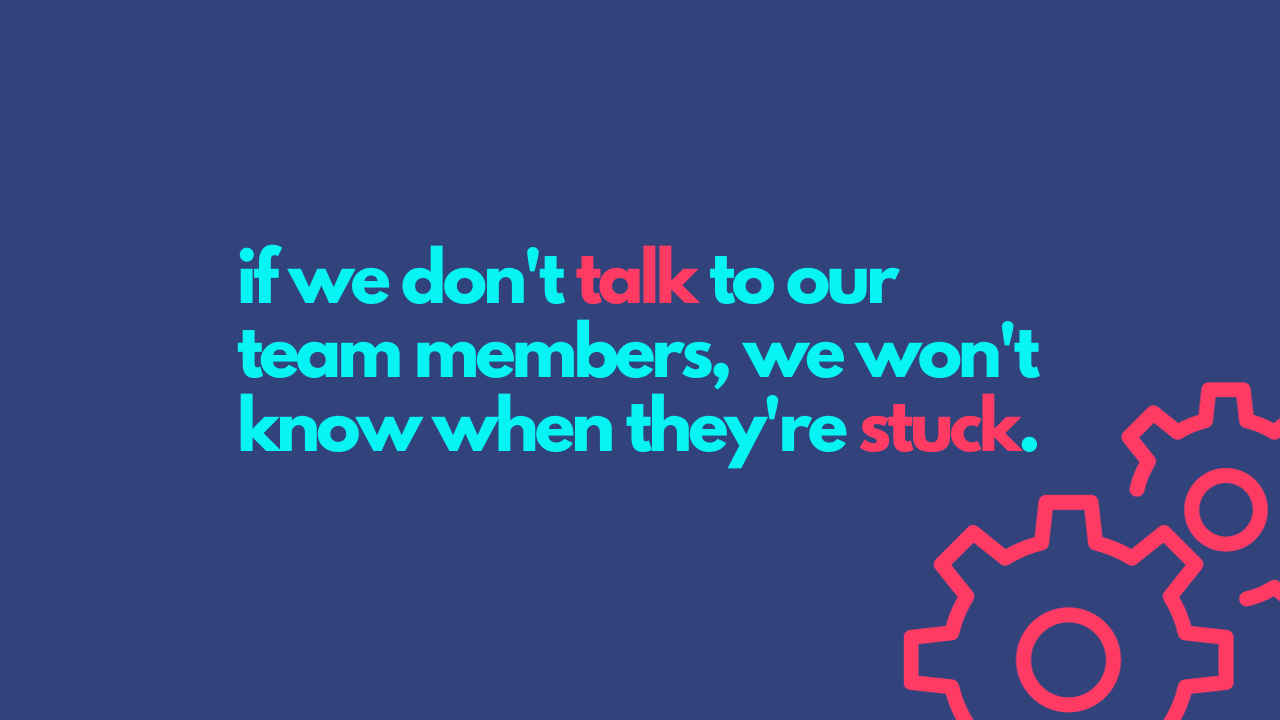There’s one thing I always recommend managers start adding to their routines with their team: one-on-one meetings with team members.
Holding meetings with each individual team member, just the two of you, is actually critically important…but not everyone knows that.
So today, I’m going to talk about why we need these meetings, what happens if we don’t have them, and how to utilize the time most effectively.
Listen on Apple | Listen on Google | Listen on Spotify
Why Individual Meetings Matter
In a world where we don’t meet with our team members frequently, there are a few issues that can start to crop up.
First off, we don’t really have a sense of what’s going on with that person internally.
We might see their work status moving through whatever tracking system we’re using. In group meetings, we might see that they’re running stuff, they’re in good shape, and things seem to be going well with their work…
But without meeting that person individually and having regular touch point, we don’t really know what’s going on with their personal well-being. They could be struggling with something outside of work. They could be feeling unmotivated or bored with their current project, or they could be overwhelmed by it and in need of support.
No matter which of these things someone is struggling with, if we’re only paying attention to whether their work is getting done, we might not realize when someone’s a flight risk to leave our team.
By not putting these one-on-one meetings in place and providing opportunities for them to come forward with these issues, we’re not just losing an opportunity to get to know our team members and establish a relationship with them—we’re relying on them to come forward themselves when something comes up.
While some team members will do that, a lot of people out there are worried about bothering you. These people can easily fly under the radar without one-on-one meetings in place.
Here’s an example of how this can begin to cause issues for our team…
I was coaching an engineer once, and she shared with me that while she had questions, she was new on the team, and she didn’t want to come across like she didn’t know what she was doing.
Not only was she knew, but she was one of the only women on the team. She was extremely proud ot be there, and she didn’t She was already, you know, one of the only women on the team and she was really proud to be there. She didn’t want to raise any flags by having questions.
However, instead of asking questions, she would work all evening trying to figure things out on her own. And because it was costing her so much of her personal time, she rapidly started to burn out; she began to wonder if she’d made the wrong choice to join this team. So without her managers even knowing, she had become a flight risk.
Once we worked together to figure out a way that she could ask for support that felt comfortable to her, she was able to start implementing that. And once she finally did start asking, she saw that a lot of the stuff she was getting stuck on was just a heap of little nuances about that particular team.
It actually had nothing to do with her ability or skillset or whether she belonged on the team or not; they were all things that folks needed to show her. And if her manager had offered the opportunity for consistent one-on-one meetings, she could have asked for that support much earlier without worrying about raising flags for the rest of the team.
This example was a big wake-up call for me that we have to be checking in with folks.

What Happens When We DO Have One-on-One Meetings
When we make time to regularly meet with our team members, we end up saving so much time, both for them and us.
Instead of using extra company time—or worse, their personal time, which can lead to burnout fast—to figure things out alone, we can often solve struggles in the span of these one-on-one meetings. And even if we can’t, we can get ahead of them and begin finding solutions before they blow up into bigger problems.
It also helps us get to know our team members and how they normally act. So when they get stuck on something and are reluctant to ask for help, we’ll be able to notice.
We’re also able to better celebrate their personal wins, which fuels motivation and builds resilience for when we’ll eventually have to ask them to put in the extra work necessary when we’re chasing down a milestone as a team.
So all in all, when we have one-on-one meetings, it allows us to utilize our team in the best way because we understand the way that they work. We understand what kinds of stretch projects to assign to them, and what kind of support they might need to be able to complete them to the best of their ability.
How To Schedule One-on-One Meetings
A lot of managers worry that they don’t have enough time to have one-on-one meetings with every team member…but it’s a lot simpler than you think!
One-on-one meetings don’t have to be lengthy—they can be as short as ten to fifteen minutes of facetime with each team member.
They also don’t have to be daily meetings, or even weekly. However, I do recommend going with a bi-weekly schedule at the longest; if you only meet with your team members once a month, that leaves a lot of time for problems to grow between sessions.
If you still feel as though you don’t have enough time, or if you don’t think you’ll have enough things to say, good news—I actually have a podcast episode all about how to structure these meetings so they serve both you and your team members best! You can find that link below!
In the meantime, the simple answer to this is just to focus on highlights and lowlights. Check in and mention what they’re doing well, and see if there’s anything they need support with.
Even if it turns out your team members don’t always need that one-to-one meeting every week, it’s important to keep that standing slot. It builds comfort and trust in your team members, because they know that they always have that space if they have a concern.
WORK WITH LIA:
Find out how to have effective one-on-one meetings with your team members: https://www.liagarvin.com/podcasts/managing-made-simple-for-team-leaders-small-business-owners/episodes/2147981993
Want a checklist of things you can do THIS month to become a better manager? Check out my Thriving Team Checklist for a list of quick actions you can take right away with your team: https://www.liagarvin.com/checklist
Book a FREE scaling strategy consultation with yours truly: calendly.com/liagarvin/scaleup-strategy?back=1&month=2023-08
Join the MANAGING MADE SIMPLE HUB, a membership community for team leaders and small business owners. This is your one-stop shop for building effective, motivated, & profitable teams: https://www.liagarvin.com/hub
CONNECT WITH LIA:
Website: https://www.liagarvin.com/




